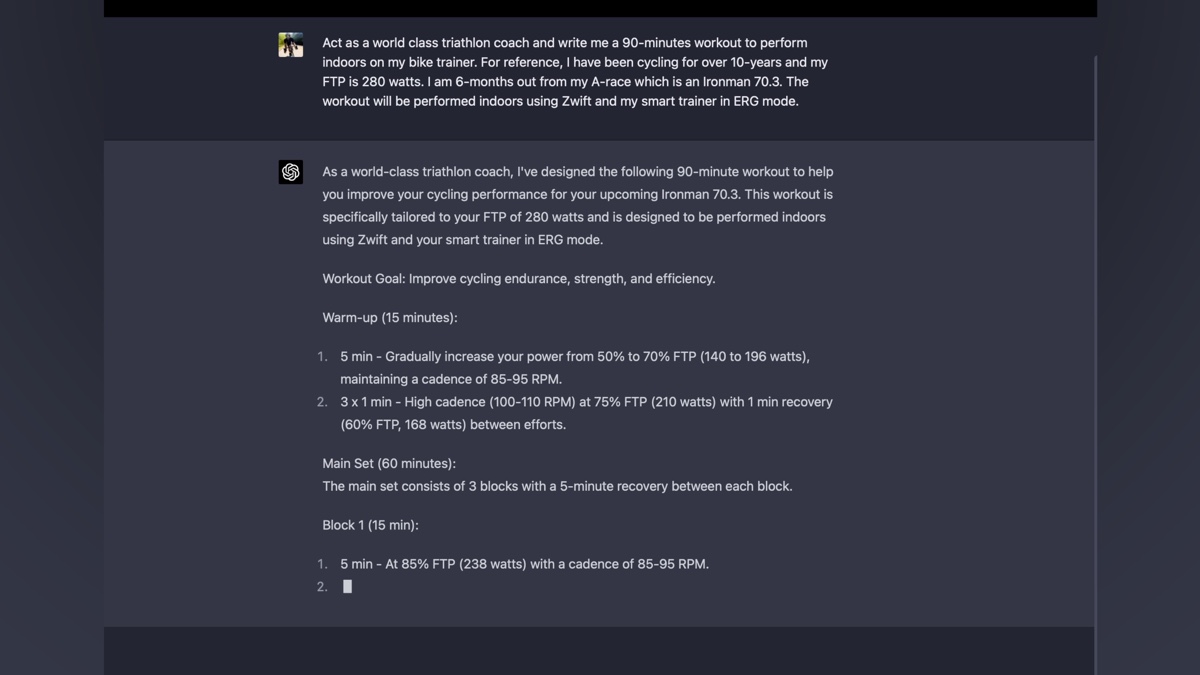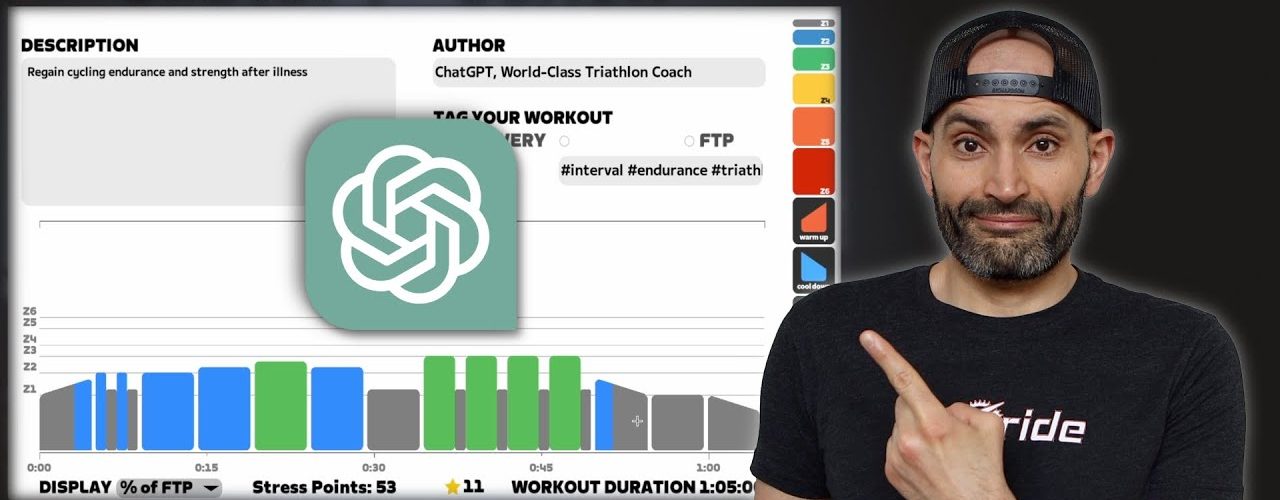The advancement of AI has begun to make its mark on various industries, including endurance sports such as cycling. With AI algorithms and machine learning models being used to create personalized training plans, many wonder if AI can eventually replace human coaches. In the video, I delve into ChatGPT’s capabilities in crafting cycling workouts and discuss its limitations compared to specialized coaching platforms.
ChatGPT and Cycling

ChatGPT is an advanced AI language model designed to generate human-like text based on user inputs. It can be engaged in conversations, provide information, and assist users across various tasks. Many individuals have been experimenting with ChatGPT to see if it can design workouts or generate training plans for them.
To test its capabilities, I asked ChatGPT to act as a world-class triathlon coach and create a 90-minute workout. The AI provided a detailed workout plan tailored to my FTP, designed to “improve cycling endurance, strength, and efficiency”. It then generated a .zwo file (an XML code used by Zwift) and even gave full instructions on how to save the code and where to copy it.

Then I went on to ask it to modify the workout after I mentioned being sick for two weeks, ChatGPT provided a less intense, 70-minute workout designed to gradually regain my cycling endurance and strength. I then asked it to calculate the TSS (Training Stress Score) and IF (Intensity Factor) for the workout, and it gave me a detailed explanation of how to calculate the estimated TSS and why it used Average power in its calculation instead of Normalized Power because it can’t accurately calculate NP because “Normalized Power calculation requires analyzing the power data in 30-second rolling averages and then taking the fourth root of the mean of the fourth power of these values.”

It also recommended using power data from the workout and software like TrainingPeaks or WKO for more accurate results.
Limitations of ChatGPT vs. Specialized Coaching Platforms

While ChatGPT’s capabilities are impressive, it’s essential to recognize the differences between general-purpose AI models like ChatGPT and specialized AI coaching platforms such as TrainerRoad and XERT. ChatGPT is designed for a broad range of tasks, while TrainerRoad and XERT focus specifically on endurance training, using your own training data and athlete feedback to provide training plans and workout recommendations. As a result, ChatGPT may lack the depth of knowledge and expertise in endurance training that these specialized platforms offer. Additionally, ChatGPT isn’t designed to process and interpret detailed training data needed to create personalized workouts and training plans.
The Future of AI and Endurance Training
As AI technology continues to evolve, we can look forward to more sophisticated tools that enhance the effectiveness and personalization of endurance training. It would be exciting to see platforms like TrainerRoad and XERT integrate AI language models like ChatGPT to provide more human-like feedback. This could help create a more immersive and engaging training experience for athletes.
In conclusion, while AI advancements are undeniably impressive, it’s important to be aware of the limitations and risks of using general-purpose AI models like ChatGPT in creating personalized training plans. The cycling app that take the initiative to push the boundaries of AI-driven coaching and training, will be in a prime position to capture a significant share of the market and set the standard for others to follow.
What are your thoughts on ChatGPT and the future of AI in endurance training? Let’s chat in the comments.
Thanks for reading!









Thanks for this post. Chatgpt is a new step in learning algorithms, but the specific and tailored approach of the likes of Trainerroad, Xert, Join Cycling and all I forget right now, is the way to go as far as training goes. There is no end all be all solution for training, hence the coaching aspect in sports. But for all of us the road to performe at a durable and sustainable level is roughly the same for about 90%. As Cyclist we have a plethora of devices that can measure about everything we do, but in the end cycling (and tri aa well) is mostly aerobic endeavour. So training that mostly with adding VO2Max, Threshold and Anaerobic is the way to go for all of us. Training the whole range in a manner with that in mind will always be a mix of pyramidal and polarised approach. More pyramidal when time is sparse, more polarised when time is more available. Or in other words more intensity when low in availability of time, more low intensity when you have more hours. Time and power distribution is the key,annd the ability to recover and adapt the main divider. So do the work and give yourself time to absorb and let your body adapt. The formentioned apps do this to a very good degree, pick one and you’ll be fine. Use Chatgpt, you wil get a random answer, that will be a reasonable guide, but only to let say 90% max, and leaves open a lot for interpretation. And there’s the root of the problem that makes us uncertain as endurance athletes, due to the sheer mass of information and data we can gather. The Trainerroads, Xerts and Join-Cycling’s of this world weed it out for you and make a scientific and adaptive plan that goes well beyond the 90% that Chatgpt will give you. Not to mention the good podcasts Trainerroad, Wahoo and Join have on numerous subjects if you want information or a deep dive. Long story short, paying some money for whatever training platform you like will definitely give you a better experience and more important, better overall cycling (and tri) performance. In the end, that’s what we are after. 🙂
Interesting post. I had AI model a newer “better” way of measuring TSS. We ran the experiment through Chat GPT 4, Claude +, Dragonfly and others to see how each AI thought of improving the TSS score. Here is the results each came up with: https://meatmotor.com/experiments-challenges/can-ai-create-a-better-training-stress-score-model/